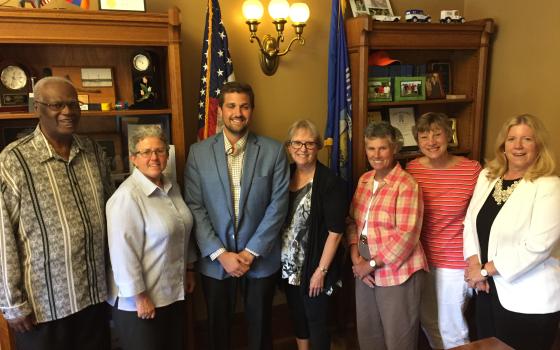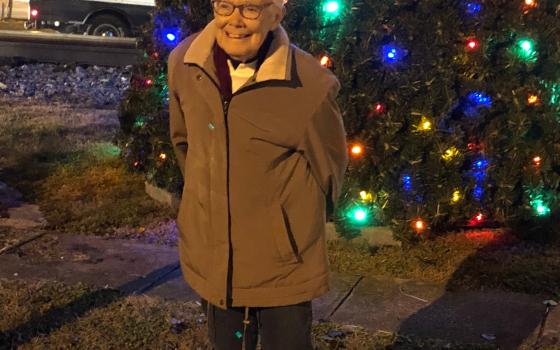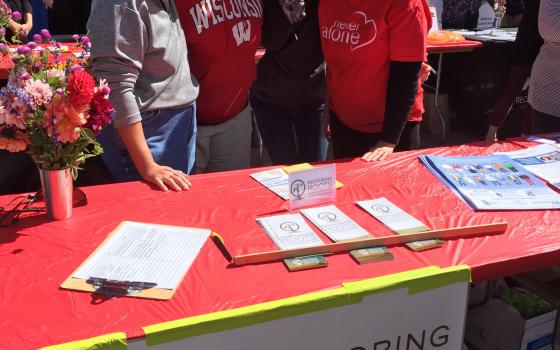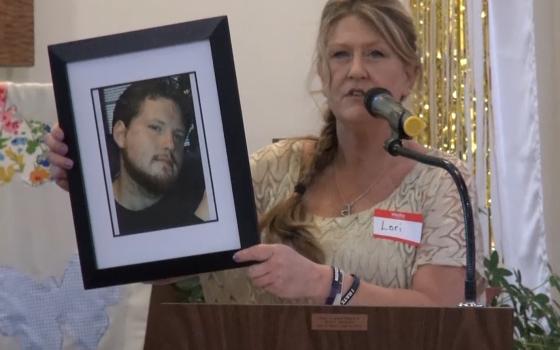In the gritty depths of the strip-mining South and in a university town in the Midwest, two Catholic sisters are working to create a future in which opioid addicts have options beyond the next fix. Beth Davies, a Notre Dame of Montreal sister, has worked for decades for health care and social justice in Appalachian Virginia. Julie Schwab, a Sinsinawa Dominican nun, is developing a residential choice for addicts in Wisconsin.
They don't know each other — but, from the way their friends and coworkers describe them, they share one strikingly similar trait: They don't give up easy.
The numbers of lives stolen by the opioid epidemic rampaging through America — a peak of nearly 200 a day in 2017, according to Centers for Disease Control and Prevention data — are so staggering that it's easy to lose sight of those working on the front lines of the crisis every day to change the script. Some offer medical intervention or a therapeutic circle in which to pursue recovery. But others, particularly those like Davies and Schwab who identify with a faith community, offer something less tangible but arguably as valuable: hope.
In Dopesick, (Little, Brown and Co., 2018), journalist Beth Macy offers an unsparing exploration of the forces behind an opioid crisis that shows little signs of abating. The opening chapters chronicle the role played by Purdue Pharma and its 1996 all-hands-on-deck effort to market its newest pain drug, OxyContin, in one of the nation's poorest regions, Appalachia.
Focusing on economically distressed areas in which mining and logging had already taken their toll in injuries, the Stamford, Connecticut-based company sent a flood of sales representatives to persuade local doctors that OxyContin was less addictive than what they were prescribing already, says Macy in a phone call.
"They were claiming it wasn't addictive and it was," says Macy. "It was like a nuclear bomb going off."
As Macy described it, pushback to the pill blitz came from an unlikely quarter.
"The first real dissent would come soon, though, in the unlikely form of a country doctor and one thoroughly pissed-off Catholic-nun-turned-drug counselor," Macy wrote in her book that often features Davies.
Asked how she feels about that description, Davies is silent for a few seconds. Then she chuckles: "I guess that's right," she says.
When opioids started to inundate the area, says Davies, "I was angry, and concerned. It happened so fast, it just bowled everybody over, like a storm coming through."
Though the St. Charles area of Lee County, Virginia, had suffered from decades of strip-mining and poverty, residents had never felt the need to lock the doors of their homes or cars, says Davies. Now people were breaking into homes and pharmacies, getting pain prescriptions from doctors so they could sell the drugs on the streets, snorting OxyContin in the high school library.
And a lot of them were dying.
A member of the Congrégation de Notre-Dame of Montreal, an international order of Catholic sisters, Davies has spent more than half of her life living in the coal country of southwestern Virginia. The region, closer to the capitals of eight other states than to its own and bordered by Kentucky and Tennessee, is so overlooked that often people don't associate it with Virginia at all, locals say.
The battle against Big Pharma didn't seem to intimidate the diminutive sister. Maybe that's because she has been so intimately engaged in multiple causes on behalf of her neighbors.
As a principal at an affluent high school in Stamford, Connecticut, Davies had been sending students down to the coalfields to do senior projects focused on theological reflection and social justice.
Then, she says, she decided to visit herself. "I knew when I left there, I was going to come back." In 1972, she moved to St. Charles (Macy describes it in her book as "the next-to-poorest town … in the poorest county in the state") with two other sisters. "What will you do if you come?" asked one man. "We'd really have to listen," Davies answered.
When Davies received the Ketteler Award for Social Justice from the Sisters of Divine Providence in 2015, a website article described what she had accomplished since she arrived on the scene. True to her promise to hear from area residents, she had been a part of "listening sessions" conducted by the Catholic Committee of Appalachia, a faith-based network of support for the region. As a member of the Virginia Citizens for Better Reclamation, she took part in the movement that resulted in legislation regulating the environmental impact of the mining industry.
Marching with miners, she had been part of strikes seeking better working conditions.
With a group of students that the Vanderbilt University School of Medicine had sent to work for the summer, she helped launch a community health fair. Then, with the help of Dr. Art Van Zee and determined residents, she became part of a community-funded effort in 1976 to create a year-round health clinic in St. Charles. That effort eventually expanded into a network of community health clinics in southwest Virginia known as Stone Mountain Health Services.
When the threat from opioids became obvious, she wasn't intimidated by the scale of the problem.
"We've got to do something to stop this company [Purdue] at its source," she recalled telling Van Zee, a respected physician who has lived in the area almost as long as Davies.
With the scope of the crisis becoming clearer, Lee County residents began coming out in force to meetings. After a packed town hall forum in 2001, Van Zee launched an online petition drive asking the Food and Drug Administration to recall OxyContin. It garnered more than 10,000 signatures.
"People realized that something had hit this county the way it never had (before)," says Davies.
She understood the nightmarish scenario around her better than many. A former active alcoholic, she had seen the inside of a jail (as the result of an accident in which she hit a car with a mother and a young child) and a treatment center on her way to recovery in 1979. "We called it the 'Irish virus,' " she says matter-of-factly. "I was an alcoholic from the moment I took my first sip."
Once she returned from treatment in Massachusetts, Davies set about helping other addicts in her community. "Because of my own recovery, I could see a lot of alcoholism among the miners, and abuse as a result."
Her experiences inspired her and a sister of Divine Providence, the late Sr. Elizabeth Vines, to launch the Pennington Gap-based Addiction Education Center in 1982, a resource for locals in an area where substance abuse treatment was rare to nonexistent. Davies herself became certified as an alcohol and drug counselor. "It was the only way we could start something," she says.
But though Davies was experienced in taking on coal companies and providing medical care, she'd never seen anything like the opioid epidemic. "It got so bad that the funeral home director called me and said, 'Beth, when are we going to stop burying people?' "
Fellow activist Jill Carson has known Davies since she and her husband, who had grown up in the area, moved to this remote slice of southwestern Virginia 30 years ago, one of a handful of African-American families in the region.
"Beth has piles of obituaries in her office — and she's probably touched all of them," says Carson. "She never misses a funeral."
In 2007, Purdue pleaded guilty to a charge of misleading regulators about the drug's addictive potential and paid a fine of $600 million as part of a plea bargain.
In a statement reported in The New York Times, the company said that since 2001 or earlier employees had made or told others to make statements to medical professionals about OxyContin that were at odds with FDA-approved prescribing information, medication risk warnings and Purdue policies. "We accept responsibility for those past misstatements and regret that they were made," the statement read.
While there are more than 1,000 opioid-themed lawsuits being levied against drug companies, with the possibility of a "tobacco-style" master settlement agreement, according to a Forbes story in August, the epidemic shows no signs of slackening.
Had Purdue executives been convicted of felonies instead of misdemeanors in 2007, says Davies, things might have been different today. The fine itself didn't go towards treatment of addicts, she added.
Macy cites evidence of progress, including access to treatment, fewer ER admissions and reduced overdose mortality in states that have supported Medicaid expansion. "What we need more than everything is for the government to take leadership and ownership of the problem," she says. "The FDA let this happen on their watch. We have no real leadership."
Has Davies' region of Virginia made progress in battling the epidemic? Too many people are still dying, she says. Suboxone, a partial opiate that blocks pain receptors, and other drugs that are part of the medical arsenal are prone to be sold and abused when not part of a treatment protocol.
Last month a subsidiary of Purdue filed a patent for a modified version of the anti-opioid drug buprenorphine.
That worried longtime observers like David Herzberg, according to this NPR story. Herzberg, a historian who focuses on the opioid epidemic, says he fears the patent could keep prices high and make it more difficult for poor addicts to get treatment, NPR reported in September. "It's hard not to have that reaction of, like … these vultures," said Herzberg, an associate professor at the University of Buffalo.
Davies, apparently indefatigable at 85, continues working a five-day week at her St. Charles office.
Last year, she received a notable honor — being asked to light the Christmas tree at the annual Pennington Gap community ceremony. "Education, health care, and civil rights are ways that Sr. Beth tries to live the Gospel call to love God and neighbor," said town administrator Keith Harless, reading from a commendation written by Jaculyn Hanrahan, a fellow Notre Dame sister and longtime friend who directs the Appalachian Faith and Ecology Center.
For decades, Davies has been living in a community that has borne much more than its fair share of hardship, whether it be mining accidents, toxic pollution or the relentless grip of an epidemic that has not let up. Yet the sister, whom Macy terms "plucky" in her ofttimes bleak Appalachian chronicle, doesn't have time to despair.
"I stay strong by seeing people in recovery and getting better," Davies says. "When you see that, it gives you hope." Even a fatal disease, she says, can be arrested. "As long as they are breathing, there is hope."
The dream of a new recovery community
"Why couldn't we do this in Wisconsin?"
Sinsinawa Dominican Sr. Julie Schwab remembers exactly the moment the idea for a residential community for addicts in recovery came to her. She was driving home from North Carolina last year.
After five years on the leadership team for her order, the 58-year-old Schwab had taken a break to earn a certificate in nonprofit management from Duke University. While in Durham, she had visited TROSA (Triangle Residential Options for Substance Abusers), a residential, multi-year program for people struggling with addiction.
As she drove home through rural Wisconsin, she heard a public radio program detailing the toll of the opioid crisis on families around the state and was struck, she says, "by how the system is failing them."
TROSA was affordable and featured long-term care and job training in a therapeutic environment.
She wondered if that model could work in Wisconsin. She began an intensive year of exploration, meeting with families touched by substance abuse, legislators, service providers and others involved in working with addicts.
"There was affirmation everywhere that there is a need for a long-term residential option," she concluded.
Medicaid and insurance don't give addicts enough time to sustain a recovery, says Schwab. "For some it's more dangerous to go into residential care, because they don't have enough support when they come out. It's a chronic illness, but we aren't responding as if it's chronic."
She recruited area residents to help fill in the details of a future residential center to be called Restoring Roots.
Though Restoring Roots is still in the blueprint stage, it incorporates the elements Schwab and her group see as crucial to long-term success, including job-skills training and a one- or two-year residency, long enough to provide space for the addicted brain to heal. Schwab and her group are researching the feasibility of on-site small businesses that would yield income for the community.
With a son in recovery, Restoring Roots board member Susanne (known as Suzi) Herbst is convinced that current courses of treatment funded by insurance don't allow enough time for the addicted brain to recover. "They need more than 30, 60 or 90 days of treatment: They need to change their way of life.
"We're wasting money trying to change a long-term problem with a short-term fix."
Schwab says she was particularly interested in hearing from African Americans and Native Americans. "It's exciting to bring together these different groups. We didn't want to create something with 500 white people," she says.
"There's a lot of resentment in the African-American community around this issue, and it's justified."
Richard Bryant, an African-American licensed substance abuse counselor who is part of Schwab's advisory group, agrees with her assessment — and is glad that addiction is finally being recognized as a disease instead of cause for prison time.
"In the African-American community we have a saying that if you don't have a seat at the table, you'll always be on the menu. We need to be at the table." Schwab and her team "get it," he says.
The working group (there's a small board and a larger body that meets regularly) envisions creating partnerships that allow clients to obtain their GED and a potential educational collaboration with nearby Edgewood College, an institution founded by the Sinsinawa sisters.
"They will have a culinary certificate and knowledge when they leave," says Schwab. "It's our hope that they can leave with transferable skills for a variety of different professions."
She and her partners are looking for a farm outside of Madison that would afford clients a chance to participate in the daily rural rituals that are part of an agricultural life. While they do that, they are also working out the nuts and bolts of a financial plan, she adds.
Schwab has also organized prayer services focused on addiction and healing. One was held at the Sinsinawa motherhouse in December 2017 and another in April in Madison.
"We have been noticing how shame and stigma that comes with addiction keeps people isolated. Neighbors have no idea about each other's suffering," Schwab writes in an email. "We decided to have a prayer service to bring people together, to be reminded that addiction is an illness, God is present even in the midst of addiction, and that we are community through the successes and tragedies that accompany it."
One of the speakers was Lori Peter, whose son, Kelly, had been in recovery almost a year before he died of an overdose in 2015, says Schwab. On other occasions, when Peter testified about addiction at the Iowa Legislature in 2017 and 2018, she took her son's ashes and put them on a table in front of the lawmakers, Schwab says.
Mary Ellen O'Grady, also a Sinsinawa sister, was present for a prayer service. She found the stories shared by participants and the ritual very powerful, she says. "It's hard for family members outside the nuclear family to have people who understand what they are going through. One person told Julie (Schwab) that it was life-changing."
Some participants returned the next week for a Taizé-style prayer service, with spoken and sung chant, meditation and prayer, says O'Grady, telling the sisters, "there are so few people who understand us and welcome us. We came back because we knew we'd be welcome."
The treatment center won't be Catholic, and will allow room for clients to incorporate their own practices into their recovery plan, says Schwab. "Anyone with a spiritual framework has a better chance to be in recovery," she says.
As Schwab works to make the vision she had on the road back from North Carolina a reality, she remembers that it isn't solely the addicted who need to be healed: It's society itself that is broken. She hopes, she says, that the rural treatment center will become a place where people can intentionally pursue practices that knit them together.
"How do we continue to belong to each other and call one another to a life of wholeness?"
[Elizabeth Eisenstadt Evans is a religion columnist for Lancaster Newspapers, Inc., as well as a freelance writer.]




